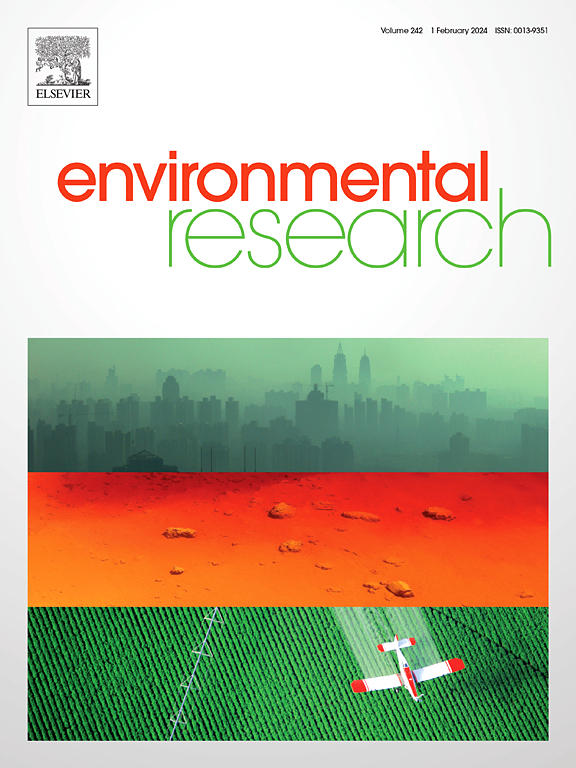中国南方某废弃锑矿土壤锑与微生物的相互作用
IF 7.7
2区 环境科学与生态学
Q1 ENVIRONMENTAL SCIENCES
引用次数: 0
摘要
锑矿开采造成的土壤污染对喀斯特生态系统具有重大的环境风险。了解微生物介导的Sb转化机制对于推进生态修复技术至关重要。系统研究了西南典型Sb矿区3个不同区域(采矿、冶炼和控制)土壤微生物群落的结构和功能响应。综合地球化学和多组学分析显示明显的Sb污染梯度。总Sb (Sbtot)浓度顺序为:熔炼区(8231.97±6875.22)>;矿区(735.03±367.21 mg/kg) >;控制区(69.11±0.47 mg/kg)。微生物群落分析显示,细菌优势(相对丰度为97.6%),其次是古细菌(2.0%)和真菌(0.4%)。值得注意的是,8个细菌属(无色杆菌、鞘单胞菌、热单胞菌、Janibacter、窄养单胞菌、Arenimonas、双歧杆菌和Halothiobacillus)表现出显著的正相关(p <;功能注释揭示了Sb生物转化与微生物代谢途径,特别是硫氧化还原循环(硫氧化:soxABXYZ;硫酸盐还原:dsrAB)和氮代谢(硝酸盐还原:narGHI)。共现网络分析表明,耐药菌与元素循环功能基因之间存在协同关系。综上所述,喀斯特土壤中的微生物Sb转化包括硫辅助电子转移和硝酸盐依赖的Sb氧化。该研究揭示了污染环境中Sb命运的生物地球化学驱动因素,并为开发适合于Sb污染喀斯特地区的基于微生物组的修复策略建立了概念框架。本文章由计算机程序翻译,如有差异,请以英文原文为准。
Soil antimony–microbe interactions in an abandoned antimony mine in southern China
Soil contamination resulting from antimony (Sb) mining activities poses a substantial environmental risk in karst ecosystems. Understanding microbially mediated Sb transformation mechanisms is critical for advancing eco-friendly remediation technologies. The structural and functional responses of soil microbial communities were systematically investigated across three distinct areas (mining, smelting, and control) in typical Sb mining regions of Southwest China. Integrated geochemical and multi-omics analyses revealed pronounced Sb contamination gradients. Total Sb (Sbtot) concentrations followed the order: smelting area (8231.97 ± 6875.22) > mining area (735.03 ± 367.21 mg/kg) > control area (69.11 ± 0.47 mg/kg). Microbial community profiling indicated bacterial dominance (97.6 % relative abundance), followed by archaea (2.0 %) and fungi (0.4 %). Notably, eight bacterial genera (Achromobacter, Sphingomonas, Thermomonas, Janibacter, Stenotrophomonas, Arenimonas, Bifidobacterium, and Halothiobacillus) exhibited significant positive correlations (p < 0.01) with Sbtot concentrations, suggesting their resistance to Sb. Functional annotation revealed critical associations between Sb biotransformation and microbial metabolic pathways, particularly sulfur redox cycling (sulfur oxidation: soxABXYZ; sulfate reduction: dsrAB) and nitrogen metabolism (nitrate reduction: narGHI). Co-occurrence network analysis indicated synergistic relationships between Sb-resistant microbes and elemental-cycling functional genes. Collectively, the results suggest that microbial Sb transformation in karst soils involves sulfur-assisted electron transfer and nitrate-dependent Sb oxidation. This study provides insight into the biogeochemical drivers of Sb fate in contaminated environments and establishes a conceptual framework for the development of microbiome-based remediation strategies suitable for Sb-polluted karst regions.
求助全文
通过发布文献求助,成功后即可免费获取论文全文。
去求助
来源期刊

Environmental Research
环境科学-公共卫生、环境卫生与职业卫生
CiteScore
12.60
自引率
8.40%
发文量
2480
审稿时长
4.7 months
期刊介绍:
The Environmental Research journal presents a broad range of interdisciplinary research, focused on addressing worldwide environmental concerns and featuring innovative findings. Our publication strives to explore relevant anthropogenic issues across various environmental sectors, showcasing practical applications in real-life settings.
 求助内容:
求助内容: 应助结果提醒方式:
应助结果提醒方式:


